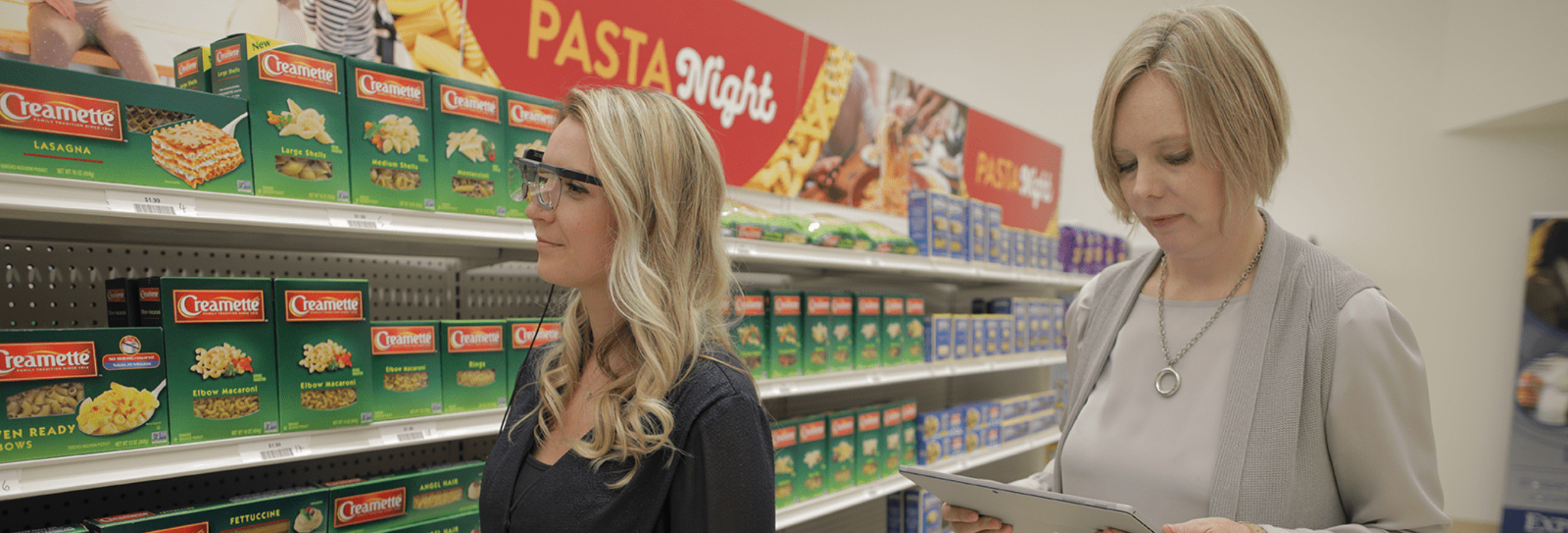As a qualitative research methodology, shop-alongs are among the most organic options available to researchers. In this shopper insights technique, researchers accompany people during a retail shopping trip to observe their behaviors in relation to store layout, signage, product placement, and customer experience with the intent to gain deep insight into consumer interactions, preferences, and decision-making processes.
Traditionally, shop-alongs have been an in-person experience in which the participant is physically accompanied on their shopping journey by a researcher. In some cases, one or two representatives from the sponsoring company may join to learn and observe shoppers’ behaviors first-hand. After the participant has completed their shop, the researcher then guides them through the environment again asking key questions about the shopper journey they just shared.
Today, however, shop-along studies are often conducted virtually. In such cases, participants conduct an in-person shopping trip at their usual brick-and-mortar retail store and take photos of any signage, store designs, or product displays that are meaningful to them. Upon returning home, they participate in a digital or online in-depth interview with a researcher via a webcam.
Ideal objectives and questions for shop-along objectives
Both in-person and virtual shop-alongs can effectively address a number of key shopper insights research objectives including improving navigation, optimizing signage, and fine-tuning product placement. Depending on the objectives, a different set of questions may arise.
Key Objectives: Store navigation and layout
- What digital or physical tools do shoppers use to navigate through the store, e.g., signs, maps, an app?
- Which directions are taken first vs later, and which directions are preferred overall?
- Which aisles are visited most frequently, e.g., interior, perimeter aisles, cross, end cap?
- Which departments are visited most frequently, e.g., pharmacy, frozen, clearance, play area?
Key Objectives: Signage and display
- What types of signs are noticed, understood, and drive sales, e.g., location, size, color, imagery?
- How do shoppers perceive aspects of the signage, whether negative or positive?
- What do the signs convey, what is the main message?
- Do some signs feel disjointed or part of a holistic message?
Key Objectives: Product placement
- How findable and noticeable are the products?
- How do shoppers feel about the product on the shelf and in their hands?
- Does the product seem to belong within the family of products?
- How does the product feel in relation to the assortment available?
Advantages and disadvantages of in-person shop-alongs
In-person shop-alongs have several key advantages. The in-person experience means that researchers can witness negative evidence first-hand – what do shoppers not look at, what do they see and disregard, what are they unable to find. In addition, researchers can observe unconscious facial expressions and body movements.
Because they take the retail journey with the shopper, the researcher is also able to gather verbal feedback, as well as audio and visual records, throughout the entire experience, as it is experienced. There are minimal concerns about inadequate or inaccurate recall in response to questioning.
In-person shop-alongs are also ideal for situations when the research objective focuses on interactions with store employees, such as with product recommendations, returns, or special orders. The researchers can personally witness interactions as an unbiased observer. There is also an opportunity to incorporate eye-tracking into the in-person research to capture what respondents are looking at in real time.
Of course, there are drawbacks to in-person shop-alongs. Because a researcher is physically accompanying the shopper, the experience may not feel as natural as it could. Consciously or unconsciously, shoppers may make adjustments to their trip, perhaps shortening or lengthening it, considering more or fewer products, or even visiting areas they might not normally visit.
Finally, privacy is perhaps the most important consideration for in-person shop-alongs. Given that detailed visual records are taken, sometimes with a device like a GoPro, researchers must take care not to capture third-party shoppers or employees who have not consented to be part of the research.
Advantages and disadvantages of virtual shop-alongs
Virtual shop-alongs also have key advantages. Because the shopper visits the retail store with no researchers and no observers, the experience is far more natural and organic. People may shop with their kids or their partner as is usual, and do so without any observers questioning their every movement.
While in-person studies are restricted to a few locations where the researcher can attend, virtual shop-alongs can benefit from national representation. Whether there is a need to understand twenty stores or fifty cities, geography is rarely a limitation. This may even result in cost savings as a researcher will not have to travel to each location, and the client can view without the need for travel – saving them money and time away from the office.
The virtual nature also provides flexibility to both participants and researchers. Shoppers can conduct their shop when it suits their schedule best, even if that means evenings, nights, or weekends. And, researchers can conduct interviews in multiple cities on the same day.
Some might think that virtual shop-alongs aren’t as engaging as in-person shop-alongs but this isn’t the case. With the right preparation and questions, the depth and quality of insights can be equal to in-person studies. Stimulus decks can be incorporated into the virtual discussion to bring shopper attention to specific in-store elements they may not have seen during their shop.
As expected, there are disadvantages to virtual shop-alongs. Even though shoppers are asked to consider their behaviors and take photos and videos while they shop, the interview itself is conducted after the shop. Efforts are always made to ensure interviews follow the shop as soon as possible, but shoppers will always struggle to remember smaller details or details that simply didn’t register for them.
Comparison of In-Person and Virtual Shop-Alongs
In-Person Shop-Along | Virtual Shop-Along | |
Retrospective Bias | + Interview takes place in-situ with live stimuli | Time lag facilitates forgetfulness |
Visual Cues | + Researchers can see unconscious behaviors, expressions | Researchers must rely on self-report |
Eye-tracking | + Can incorporate eye-tracking | |
Technical | + Fewer technical concerns | Requires technically savvy and prepared participants and observers |
Observer bias | Observers may directly or indirectly influence participants | + Shopper behaviors are more organic, natural |
Reach | Limited to researcher's location | + Unlimited, national, more representative |
Cost | Requires travel budget for researcher and client | + No travel budget or client time away from office is required |
Coordination | Inflexible scheduling required | + Flexible and convenient for participant |
Privacy | More concerns due to the presence of cameras and observers | + Few concerns |
Tips for maximum success of your shop-along
- Test the technology. For virtual shop-alongs, ensure everyone participating in the research tests their technology ahead of time. Whether a research participant or corporate observer there’s nothing more stressful in a study than being unable to log into an interview portal just as the interview is about to begin.
- Establish protocols for feedback. Rather than overwhelming the moderator with feedback from multiple observers, identify one key contact person from among the observers who will collect all of their feedback and share it at defined times with the moderator
- Visit the store ahead of time. For in-person shop-alongs, researchers should allow sufficient advance time to visit the retail research environment. They need to learn the store layout and identify products, signage, and features that should be highlighted as part of the analysis.
- Observe, don’t interact. As tempting as it is to jump in with small questions, observers should never interfere or influence the shop. There will be times when the moderator is seeking to establish unaided noticeability or findability, and interruptions could invalidate those results.
- Minimize the number of observers. When choosing observers to participate in an in-person shop-along, minimize the number of people involved. Too many observers can overwhelm and intimidate the shopper, resulting in unnatural behaviors that can invalidate the results.
Summary
Shop-alongs are a fantastic shopper insights methodology for understanding customer experience as it relates to retail navigation, signage, product placement questions, and retail store design. By immersing researchers in the shopping environment with participants, a deeper understanding of the customer experiences can be gained, enabling businesses to tailor their strategies and offerings to better meet the needs and desires of their target audience.
If you’re ready to deeply understand your shoppers, get in touch with the shopper insights experts at Explorer Research. We have the deep knowledge and tools to help you understand your customers, and ultimately build a stronger path to purchase.


